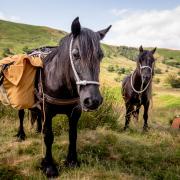If you’ve not picked up a paintbrush since you left school, now could be the perfect time to get creative, says Laura Heap, the head of art and design at Rossall School.

The first task is to establish what art materials you have available. You don’t need top-of-the-range equipment, or a new set of paints and brushes - some leftover wallpaper and an old pen or pencil will do. You could even create a collage using torn up copies of Lancashire Life (just make sure everyone has read them first). If do need equipment, it is posible to finds things online, or at the supermarket when you’re doing that essential food shop.
Start by doing a little research and finding some pieces of artwork you like. Pinterest is fantastic for finding artworks you may want to copy and many galleries are currently offering free virtual tours online which are a great way of discovering new works.
Sometimes it is easier to get going by copying other artists’ work; their styles, techniques and how the paint has been applied and markings have been made. Some of the greatest masters learned in this way. The main thing is to get started, be bold and enjoy yourself. If that huge canvas or paper feels a little intimidating, just try a few smaller tests to build your confidence, then move on to the bigger pieces.
If you have copied a few pieces and feel happy to start producing your own work, try to be inspired by some of the artists’ styles you have already adopted. Still life is always a good place to start; I believe in traditional skills of observation and composition, drawing things you believe to be beautiful. Set up flowers, fruit and use fabric to create a backdrop and nice folds. Think about where you position each of the items, quite close together, to make a pleasing composition.
If you are not sure where to start, spend a few minutes looking at what you are trying to draw. Start by creating a few measurements - roughly where is half way up or across, what you are hoping to draw, make these markings on your paper. Measure between reference points and how they relate to others by holding your pencil at arms-length and measuring distances with your thumb. After an hour or so, you may only have a series of markings and points from which to get started on ‘joining up the dots’. The more accurate information you get on the page, the easier it is, a bit like a jigsaw puzzle coming together.
Always start lightly and gradually build up the whole piece. If anything is in the wrong place, do not be afraid to rub it out and correct it. Once you’re happy everything is in the right place, gradually add in more detail and strengthen your lines. When you are happy with your drawing, you can start adding tone or colour to your work. Be patient and don’t expert to create a masterpiece straight away.
It takes time and careful observation to build up detail and when adding tone or colour, many layers are important to create depth and form. Note the direction from which light is coming, observing parts to highlight and parts in shade.
Some people say they can’t do art. This is never true; everyone has ability in some form of art and design, they may just not have found their niche. If observational drawing is a challenge, try pattern or abstract painting, textile design or ceramic sculpture.
Make use of technology. Take photographs and edit them, to enhance colour and shadow, to improve those pictures, then maybe try drawing the image. If photography is more your thing, don’t miss our tips on page ??
Remember, you might not always achieve just what you intend at the first attempt, it is important to practise those skills. Completing an artwork, which you can hang on your wall or give as a gift can be very rewarding and provide a great sense of achievement. You are never too old to start and give it a go - you have nothing to lose and you might surprise yourself.
If you do dig out your pencils and paper, be sure to share your results with us.



























